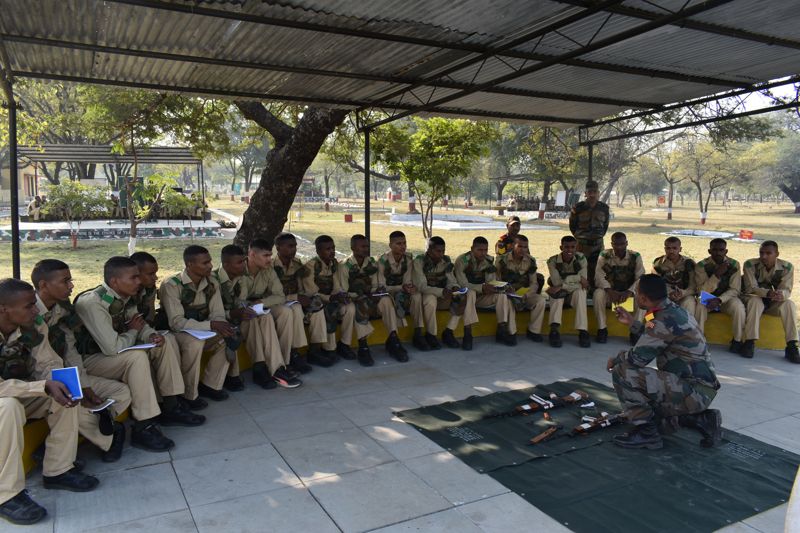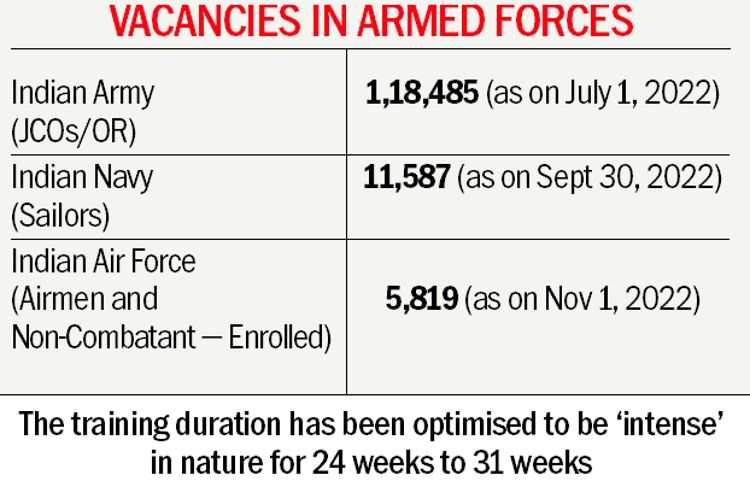As Agnipath recruitment and soldiering policy of armed forces becomes operational, a look at challenges that lie ahead

Ajay Banerjee
SIX months after the Ministry of Defence (MoD) announced a new policy — Agnipath — on recruiting troops for the armed forces, the first batch of recruits commenced training last week at multiple establishments across the country.
These young men — about 26,000 in number — are in the age group of 17 to 23 and have been picked up after a rigorous selection process from among 60 lakh applicants. They will serve the armed forces for a period of four years. About 25 per cent of these recruits will be offered positions as full-time soldiers for a longer service of 15 to 17 years.
The Agnipath scheme, considered the single biggest military reform since Independence, was announced by Defence Minister Rajnath Singh on June 14 last year. The announcement was met by violent protests by the youth across several states. From veterans to parliamentarians, many ‘warned’ the government against going ahead with the scheme. Following the uproar, a few tweaks, such as increasing the age limit, were made in the scheme. Lakhs of young men and women turned up at the recruitment rallies.
The Army received 37 lakh applications while there were 7.7 lakh and 15 lakh applications for the Indian Air Force and the Navy, respectively. Of these, 20,000 were selected in the Army and about 3,000 each recruited into the Navy and the IAF.
The Army, which has had no recruitment since 2020 and has an existing shortfall of troops, will add 20,000 more by March and will also start taking women at the same time. Meanwhile, the Navy has already started the recruitment of women.
Intense training schedule
Training methodology and infrastructure have been adapted to meet the needs for ‘future-ready’ soldiers and cater to the short duration of engagement of Agniveers in the forces. The training duration has been optimised to be ‘intense’ in nature for 24 weeks to 31 weeks. Earlier, training schedules in the Army varied from six months to two years, depending on the stream the jawan was selected into.
The big change is having some 500 simulators for training on various weapons and creation of infrastructure. All training centres have sports injury specialists as a pre-emptive measure for preventing stress injuries.https://aa5c801b82a0dc636c829de97fad4552.safeframe.googlesyndication.com/safeframe/1-0-40/html/container.html
The IAF and the Navy are more technology-intensive compared to the Army, and, hence, recruit youths with a science background after a written examination.
After a compressed training programme of six months, the second round of training will be held at Army regiments, IAF squadrons or Naval establishments. According to Maj Gen Ashok Kumar (retd), who has been an instructor at the Army Air Defence College and Indian Military Academy, “On-the-job training (the second round of training) has been an essential component even in pre-Agnipath times.”
Is six-month training enough?
When the MoD announced that the basic training period for Agniveers would be of six months, many questions were raised. According to a serving officer, “Training schedule with breaks has been a pre-Independence practice.
Col DPK Pillay (retd), Research Fellow at the Institute of Defence Studies and Analyses (IDSA), says, “Every system needs a periodic overhaul. In the 1950s, ’60s or ’70s, literacy levels were low and recruits needed to be brought at a par. Today, literacy levels have gone up and the level of technological awareness is high. So, a truncated, scientifically-designed training tenure is sufficient.”
Maj Gen Kumar adds, “Modern training techniques allow reduced durations. Entry-level standards, through physical tests and written tests, improve the quality of intake.”
The government argument
The Agnipath scheme has been designed to enable a youthful profile to the armed forces and take in the youth in tune with the contemporary technological trends. The forces are looking at a transformational shift towards a more tech-oriented role. The scheme will lower the age profile of Indian armed forces by four to five years. Col Pillay explains, “We need soldiers who are willing to learn new technology and adapt themselves to military situations.
What after four years?
With just 25 per cent of Agniveers getting selected for full-time soldiering, questions are being raised on the future of youth who are released from service and how military-trained youth will be absorbed in jobs after four years.
The Agnipath scheme does not offer pension but has a payout in case of injuries. Till the early 1980s, troops served for seven years and only a small percentage earned pension after putting in 15 years of service.
In a multi-pronged approach, the MoD has roped in the Society of Indian Defence Manufacturers (SIDM) and taken ‘suggestions’ on industry-specific skills needed by Agniveers. The private sector is making aerostructures, guns, tanks, and even ships. The public sector has been making planes, helicopters, ships, guns and missiles. Public sector and private banks have signed up to provide soft loans to Agniveers after they exit from the services for starting their own enterprises.
The MoD has reserved 10 per cent of job vacancies. The Union Home Ministry has reserved 10 per cent vacancies for recruitment in the Central Armed Police Forces (CAPFs) and Assam Rifles for ‘Agniveers’. Several state governments have announced supportive measures.
Last week, separate MoUs were signed by the MoD with the Ministry of Education (MoE) and the Ministry of Skill Development and Entrepreneurship (MoSDE) to facilitate continued education of Agniveers while serving in the armed forces and for the award of appropriate skill certificates.
Need to balance the gaps
A stark gap exists in case of an Agniveer and a regular soldier getting killed in action. The family of a serving Agniveer would get Rs 1.04 crore as compensation, besides full pay for the unserved period up to four years (effective from the date of death), along with the Seva Nidhi fund.
However, in case a regular soldier is killed in action, besides the one-time compensation, there is a fund of insurance, and the widow or parents are entitled to family pension till they are alive. The children get fully-funded free education till graduation in an institute of choice. Thus, if the child of a soldier, who has sacrificed his life, clears a medical or engineering entrance examination, the fee is paid by the MoD.
No change in regimental system
The Agnipath scheme is not expected to make a major change in the ‘class-specific’ regiments, which have, for more than 150 years, recruited boys from the same gene pool and defined geographical locations.
Those recruited from the same gene pool would be inducted into existing ‘class-specific’ regiments. For example, a Sikh recruited as an Agniveer would be allocated to one of the battalions of the Sikh Regiment. It would be similar for a Jat Agniveer, and so on.
Class-specific regiments, among others, include the Sikh, the Sikh Light Infantry, the Gorkhas, the Dogra, the Jat, J&K Light Infantry and Rajputana Rifles and some of these have existed since the times of the British.
Maj Gen Kumar explains, “The ethos of a regiment is related to the value system being followed in a particular regiment.” Since 25 per cent are being retained on a permanent basis, there will not be too much of stress on the fabric of regiments and this is not likely to create any major disruptions, the General adds.
The Agnipath scheme mandates an all-India merit-based selection termed ‘All India All Class’. In the long run, some 10 years down the line, the number of troops from ‘All India All Class’ origin would not form more than 10 per cent of the strength in a ‘class-specific’ battalion. The strength of a battalion is about 850-900 men and there are multiple battalions in a regiment.
Almost 75 per cent of the Army is ‘All India All Class’, only a limited have ‘class-specific’formations. No compromise is expected on the ethos of ‘Naam Namak Nishaan’. Each regiment has a specific war cry (Naam), a flag (Nishan) and a specific diet (Namak)
